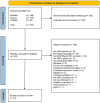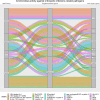Revolutionizing orthopedic healthcare: a systematic review unveiling recombinant antimicrobial peptides
- PMID: 38756724
- PMCID: PMC11097975
- DOI: 10.3389/fmicb.2024.1370826
Revolutionizing orthopedic healthcare: a systematic review unveiling recombinant antimicrobial peptides
Abstract
The increasing demand for orthopedic surgeries, including joint replacements, is driven by an aging population and improved diagnosis of joint conditions. Orthopedic surgeries carry a risk of infection, especially in patients with comorbidities. The rise of antibiotic resistance exacerbates this issue, necessitating alternatives like in vitro bioengineered antimicrobial peptides (AMPs), offering broad-spectrum activity and multiple action mechanisms. This review aimed to assess the prevalence of antimicrobial potential and the yield after purification among recombinant AMP families. The antimicrobial potential was evaluated using the Minimum Inhibitory Concentration (MIC) values against the most common bacteria involved in clinical infections. This systematic review adhered to PRISMA guidelines, focusing on in vitro studies of recombinant AMPs. The search strategy was run on PubMed, Scopus and Embase up to 30th March 2023. The Population, Exposure and Outcome model was used to extract the data from studies and ToxRTool for the risk of bias analysis. This review included studies providing peptide production yield data and MIC values against pathogenic bacteria. Non-English texts, reviews, conference abstracts, books, studies focusing solely on chemical synthesis, those reporting incomplete data sets, using non-standard MIC assessment methods, or presenting MIC values as ranges rather than precise concentrations, were excluded. From 370 publications, 34 studies on AMPs were analyzed. These covered 46 AMPs across 18 families, with Defensins and Hepcidins being most common. Yields varied from 0.5 to 2,700 mg/L. AMPs were tested against 23 bacterial genera, with MIC values ranging from 0.125 to >1,152 μg/mL. Arenicins showed the highest antimicrobial activity, particularly against common orthopedic infection pathogens. However, AMP production yields varied and some AMPs demonstrated limited effectiveness against certain bacterial strains. This systematic review emphasizes the critical role of bioengineered AMPs to cope infections and antibiotic resistance. It meticulously evaluates recombinant AMPs, focusing on their antimicrobial efficacy and production yields. The review highlights that, despite the variability in AMP yields and effectiveness, Arenicins and Defensins are promising candidates for future research and clinical applications in treating antibiotic-resistant orthopedic infections. This study contributes significantly to the understanding of AMPs in healthcare, underscoring their potential in addressing the growing challenge of antibiotic resistance. Systematic review registration:https://osf.io/2uq4c/.
Keywords: antibiotic resistance; minimum inhibitory concentration; orthopedic infections; recombinant antimicrobial peptides; yield.
Copyright © 2024 Pennone, Rosini, Mascheroni, Gianola, Castellini, Bargeri and Lovati.
Conflict of interest statement
The authors declare that the research was conducted in the absence of any commercial or financial relationships that could be construed as a potential conflict of interest. The author(s) declared that they were an editorial board member of Frontiers, at the time of submission. This had no impact on the peer review process and the final decision.
Figures








References
-
- Arias M., Hoffarth E. R., Ishida H., Aramini J. M., Vogel H. J. (2016). Recombinant expression, antimicrobial activity and mechanism of action of tritrpticin analogs containing fluoro-tryptophan residues. Biochim. Biophys. Acta Biomembr. 1858, 1012–1023. doi: 10.1016/j.bbamem.2015.12.023, PMID: - DOI - PubMed
Publication types
LinkOut - more resources
Full Text Sources

